Analysis of Planetary Boundaries and UN Sustainable Development
VerifiedAdded on 2023/06/04
|5
|1464
|305
Essay
AI Summary
This essay examines the relationship between planetary boundaries and the United Nations' 2030 Agenda for Sustainable Development, focusing on the 17 development goals and 169 targets aimed at addressing global challenges. It highlights the five critical components guiding the declaration: people, planet, prosperity, peace, and partnership. The reflection on the Millennium Development Goals emphasizes the importance of sustainability, inclusivity, and justice in achieving these agendas. It underscores the need for policies promoting accountability, resilient communities, and responsible consumption. The essay concludes by urging developed nations to reduce greenhouse gas emissions, prevent water pollution, and foster peaceful environments to ensure the success of sustainable development goals and the well-being of future generations. It calls for gender equality, investment in independent institutions to combat corruption, and the adoption of sustainable agricultural practices.
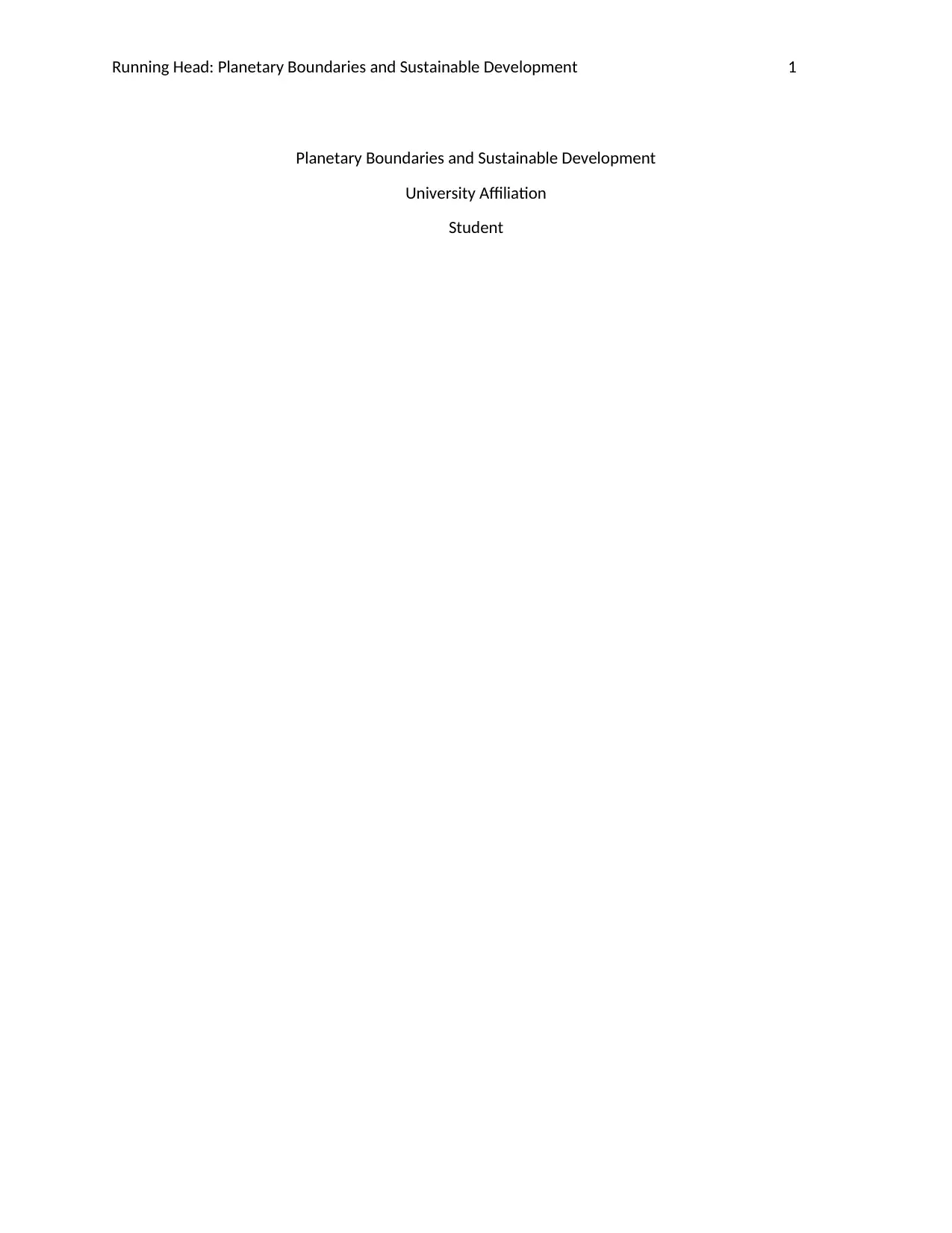
Running Head: Planetary Boundaries and Sustainable Development 1
Planetary Boundaries and Sustainable Development
University Affiliation
Student
Planetary Boundaries and Sustainable Development
University Affiliation
Student
Paraphrase This Document
Need a fresh take? Get an instant paraphrase of this document with our AI Paraphraser
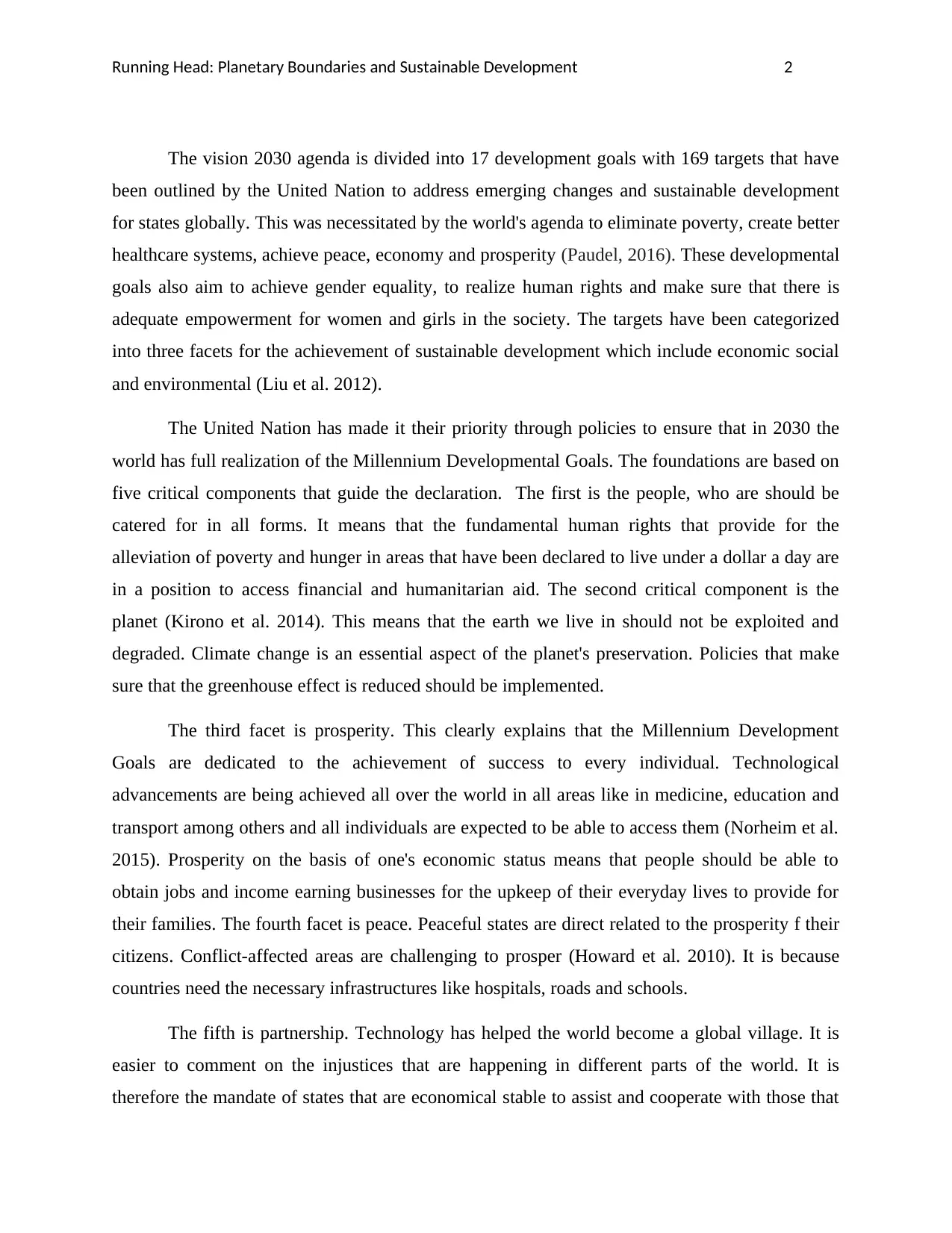
Running Head: Planetary Boundaries and Sustainable Development 2
The vision 2030 agenda is divided into 17 development goals with 169 targets that have
been outlined by the United Nation to address emerging changes and sustainable development
for states globally. This was necessitated by the world's agenda to eliminate poverty, create better
healthcare systems, achieve peace, economy and prosperity (Paudel, 2016). These developmental
goals also aim to achieve gender equality, to realize human rights and make sure that there is
adequate empowerment for women and girls in the society. The targets have been categorized
into three facets for the achievement of sustainable development which include economic social
and environmental (Liu et al. 2012).
The United Nation has made it their priority through policies to ensure that in 2030 the
world has full realization of the Millennium Developmental Goals. The foundations are based on
five critical components that guide the declaration. The first is the people, who are should be
catered for in all forms. It means that the fundamental human rights that provide for the
alleviation of poverty and hunger in areas that have been declared to live under a dollar a day are
in a position to access financial and humanitarian aid. The second critical component is the
planet (Kirono et al. 2014). This means that the earth we live in should not be exploited and
degraded. Climate change is an essential aspect of the planet's preservation. Policies that make
sure that the greenhouse effect is reduced should be implemented.
The third facet is prosperity. This clearly explains that the Millennium Development
Goals are dedicated to the achievement of success to every individual. Technological
advancements are being achieved all over the world in all areas like in medicine, education and
transport among others and all individuals are expected to be able to access them (Norheim et al.
2015). Prosperity on the basis of one's economic status means that people should be able to
obtain jobs and income earning businesses for the upkeep of their everyday lives to provide for
their families. The fourth facet is peace. Peaceful states are direct related to the prosperity f their
citizens. Conflict-affected areas are challenging to prosper (Howard et al. 2010). It is because
countries need the necessary infrastructures like hospitals, roads and schools.
The fifth is partnership. Technology has helped the world become a global village. It is
easier to comment on the injustices that are happening in different parts of the world. It is
therefore the mandate of states that are economical stable to assist and cooperate with those that
The vision 2030 agenda is divided into 17 development goals with 169 targets that have
been outlined by the United Nation to address emerging changes and sustainable development
for states globally. This was necessitated by the world's agenda to eliminate poverty, create better
healthcare systems, achieve peace, economy and prosperity (Paudel, 2016). These developmental
goals also aim to achieve gender equality, to realize human rights and make sure that there is
adequate empowerment for women and girls in the society. The targets have been categorized
into three facets for the achievement of sustainable development which include economic social
and environmental (Liu et al. 2012).
The United Nation has made it their priority through policies to ensure that in 2030 the
world has full realization of the Millennium Developmental Goals. The foundations are based on
five critical components that guide the declaration. The first is the people, who are should be
catered for in all forms. It means that the fundamental human rights that provide for the
alleviation of poverty and hunger in areas that have been declared to live under a dollar a day are
in a position to access financial and humanitarian aid. The second critical component is the
planet (Kirono et al. 2014). This means that the earth we live in should not be exploited and
degraded. Climate change is an essential aspect of the planet's preservation. Policies that make
sure that the greenhouse effect is reduced should be implemented.
The third facet is prosperity. This clearly explains that the Millennium Development
Goals are dedicated to the achievement of success to every individual. Technological
advancements are being achieved all over the world in all areas like in medicine, education and
transport among others and all individuals are expected to be able to access them (Norheim et al.
2015). Prosperity on the basis of one's economic status means that people should be able to
obtain jobs and income earning businesses for the upkeep of their everyday lives to provide for
their families. The fourth facet is peace. Peaceful states are direct related to the prosperity f their
citizens. Conflict-affected areas are challenging to prosper (Howard et al. 2010). It is because
countries need the necessary infrastructures like hospitals, roads and schools.
The fifth is partnership. Technology has helped the world become a global village. It is
easier to comment on the injustices that are happening in different parts of the world. It is
therefore the mandate of states that are economical stable to assist and cooperate with those that
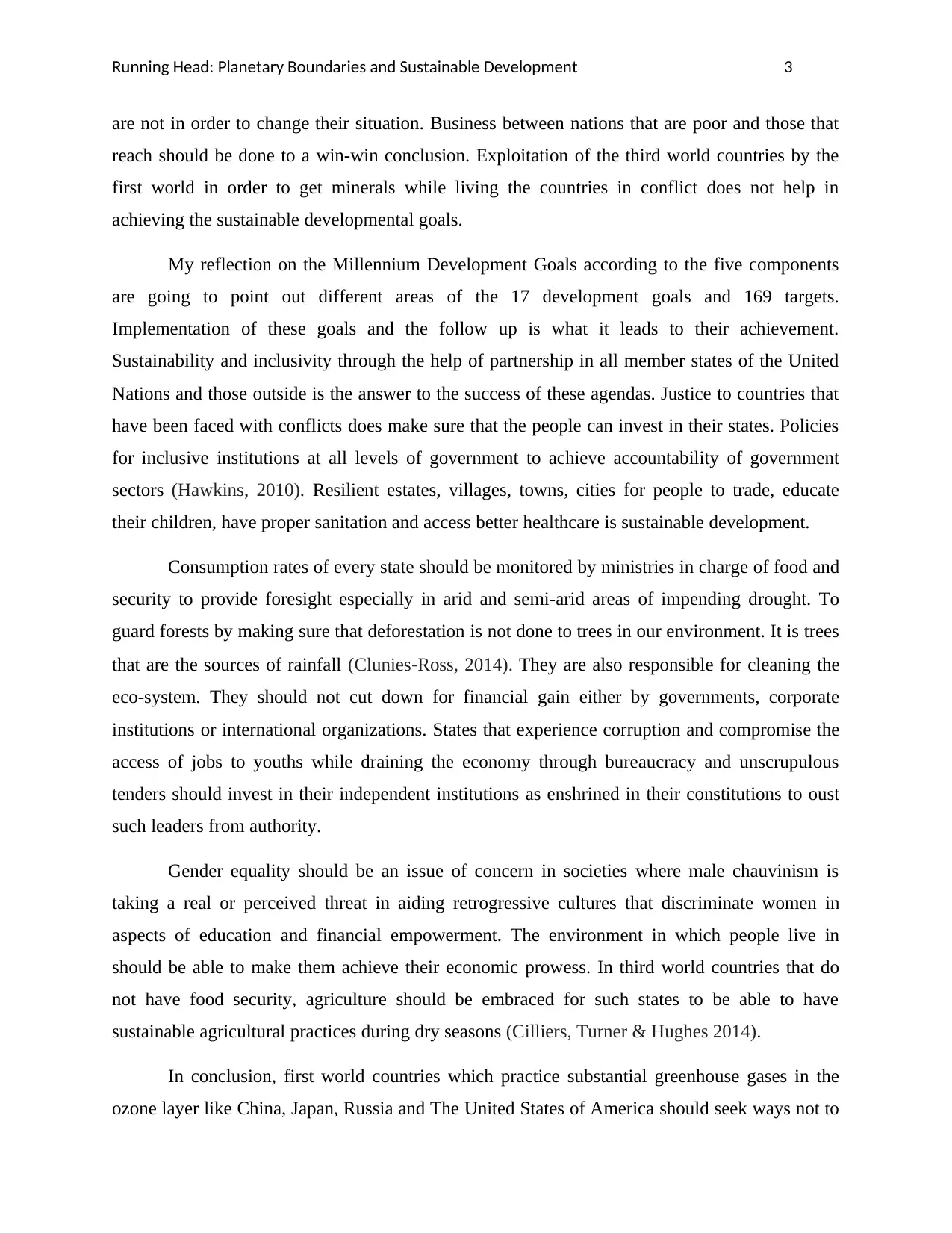
Running Head: Planetary Boundaries and Sustainable Development 3
are not in order to change their situation. Business between nations that are poor and those that
reach should be done to a win-win conclusion. Exploitation of the third world countries by the
first world in order to get minerals while living the countries in conflict does not help in
achieving the sustainable developmental goals.
My reflection on the Millennium Development Goals according to the five components
are going to point out different areas of the 17 development goals and 169 targets.
Implementation of these goals and the follow up is what it leads to their achievement.
Sustainability and inclusivity through the help of partnership in all member states of the United
Nations and those outside is the answer to the success of these agendas. Justice to countries that
have been faced with conflicts does make sure that the people can invest in their states. Policies
for inclusive institutions at all levels of government to achieve accountability of government
sectors (Hawkins, 2010). Resilient estates, villages, towns, cities for people to trade, educate
their children, have proper sanitation and access better healthcare is sustainable development.
Consumption rates of every state should be monitored by ministries in charge of food and
security to provide foresight especially in arid and semi-arid areas of impending drought. To
guard forests by making sure that deforestation is not done to trees in our environment. It is trees
that are the sources of rainfall (Clunies‐Ross, 2014). They are also responsible for cleaning the
eco-system. They should not cut down for financial gain either by governments, corporate
institutions or international organizations. States that experience corruption and compromise the
access of jobs to youths while draining the economy through bureaucracy and unscrupulous
tenders should invest in their independent institutions as enshrined in their constitutions to oust
such leaders from authority.
Gender equality should be an issue of concern in societies where male chauvinism is
taking a real or perceived threat in aiding retrogressive cultures that discriminate women in
aspects of education and financial empowerment. The environment in which people live in
should be able to make them achieve their economic prowess. In third world countries that do
not have food security, agriculture should be embraced for such states to be able to have
sustainable agricultural practices during dry seasons (Cilliers, Turner & Hughes 2014).
In conclusion, first world countries which practice substantial greenhouse gases in the
ozone layer like China, Japan, Russia and The United States of America should seek ways not to
are not in order to change their situation. Business between nations that are poor and those that
reach should be done to a win-win conclusion. Exploitation of the third world countries by the
first world in order to get minerals while living the countries in conflict does not help in
achieving the sustainable developmental goals.
My reflection on the Millennium Development Goals according to the five components
are going to point out different areas of the 17 development goals and 169 targets.
Implementation of these goals and the follow up is what it leads to their achievement.
Sustainability and inclusivity through the help of partnership in all member states of the United
Nations and those outside is the answer to the success of these agendas. Justice to countries that
have been faced with conflicts does make sure that the people can invest in their states. Policies
for inclusive institutions at all levels of government to achieve accountability of government
sectors (Hawkins, 2010). Resilient estates, villages, towns, cities for people to trade, educate
their children, have proper sanitation and access better healthcare is sustainable development.
Consumption rates of every state should be monitored by ministries in charge of food and
security to provide foresight especially in arid and semi-arid areas of impending drought. To
guard forests by making sure that deforestation is not done to trees in our environment. It is trees
that are the sources of rainfall (Clunies‐Ross, 2014). They are also responsible for cleaning the
eco-system. They should not cut down for financial gain either by governments, corporate
institutions or international organizations. States that experience corruption and compromise the
access of jobs to youths while draining the economy through bureaucracy and unscrupulous
tenders should invest in their independent institutions as enshrined in their constitutions to oust
such leaders from authority.
Gender equality should be an issue of concern in societies where male chauvinism is
taking a real or perceived threat in aiding retrogressive cultures that discriminate women in
aspects of education and financial empowerment. The environment in which people live in
should be able to make them achieve their economic prowess. In third world countries that do
not have food security, agriculture should be embraced for such states to be able to have
sustainable agricultural practices during dry seasons (Cilliers, Turner & Hughes 2014).
In conclusion, first world countries which practice substantial greenhouse gases in the
ozone layer like China, Japan, Russia and The United States of America should seek ways not to
⊘ This is a preview!⊘
Do you want full access?
Subscribe today to unlock all pages.

Trusted by 1+ million students worldwide
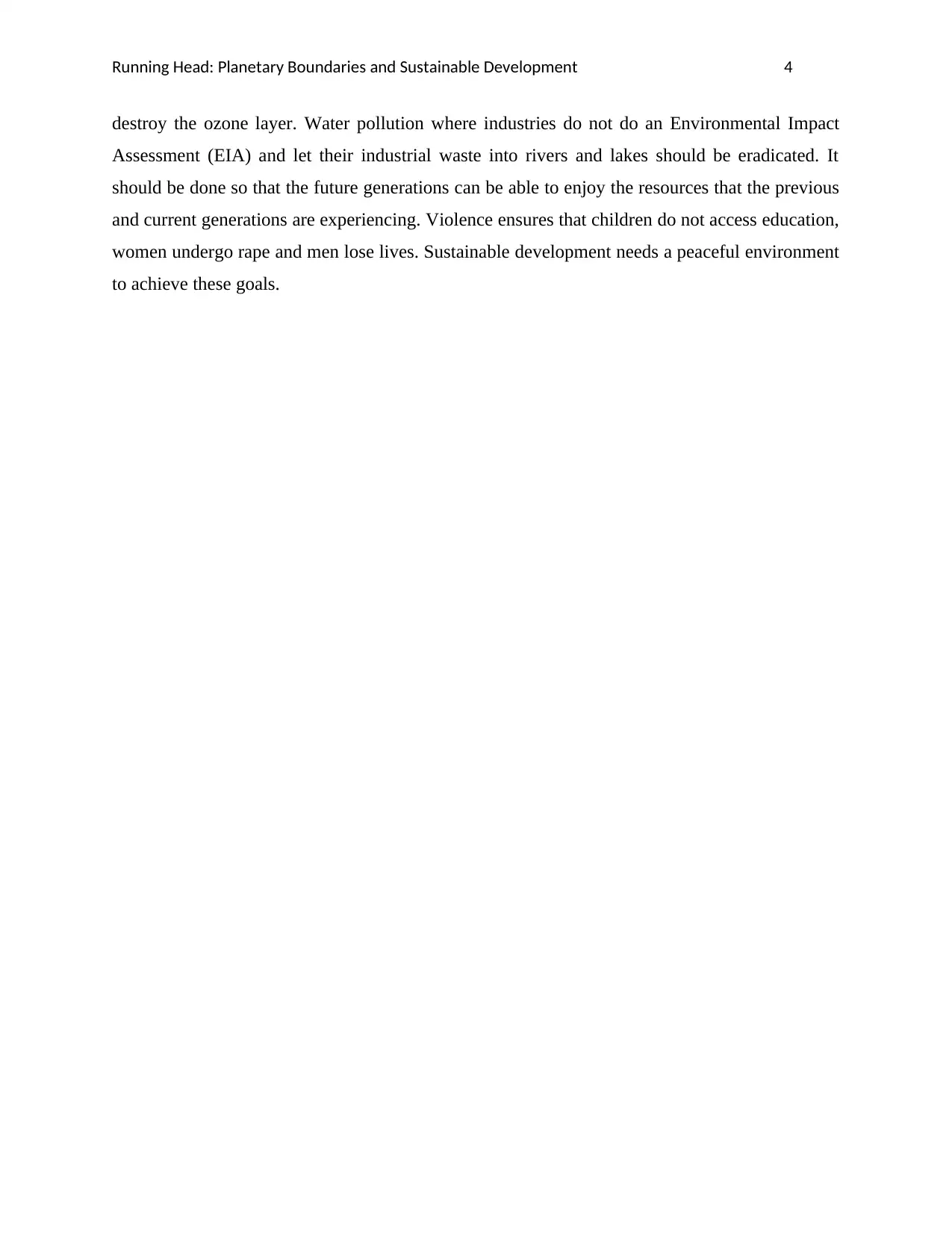
Running Head: Planetary Boundaries and Sustainable Development 4
destroy the ozone layer. Water pollution where industries do not do an Environmental Impact
Assessment (EIA) and let their industrial waste into rivers and lakes should be eradicated. It
should be done so that the future generations can be able to enjoy the resources that the previous
and current generations are experiencing. Violence ensures that children do not access education,
women undergo rape and men lose lives. Sustainable development needs a peaceful environment
to achieve these goals.
destroy the ozone layer. Water pollution where industries do not do an Environmental Impact
Assessment (EIA) and let their industrial waste into rivers and lakes should be eradicated. It
should be done so that the future generations can be able to enjoy the resources that the previous
and current generations are experiencing. Violence ensures that children do not access education,
women undergo rape and men lose lives. Sustainable development needs a peaceful environment
to achieve these goals.
Paraphrase This Document
Need a fresh take? Get an instant paraphrase of this document with our AI Paraphraser
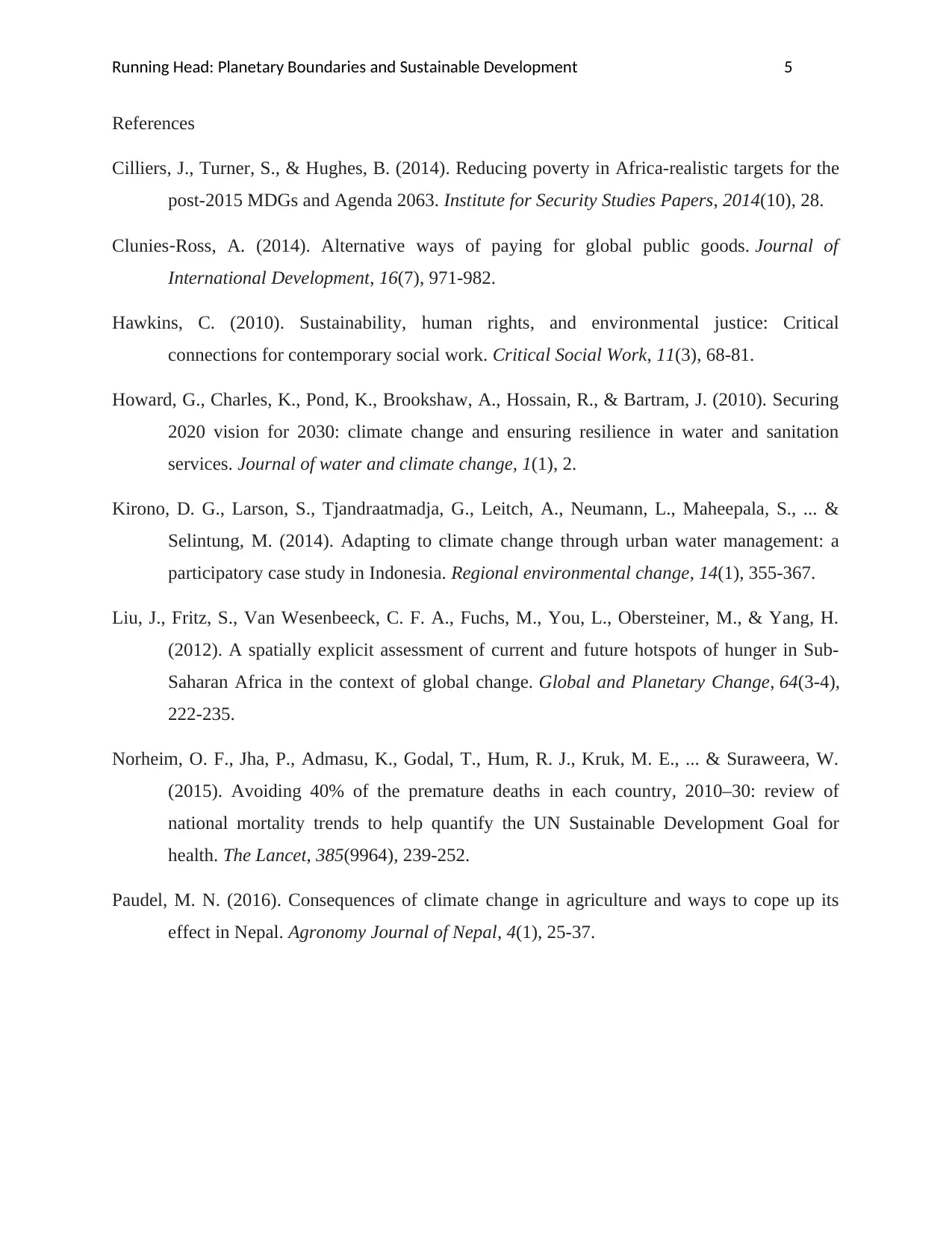
Running Head: Planetary Boundaries and Sustainable Development 5
References
Cilliers, J., Turner, S., & Hughes, B. (2014). Reducing poverty in Africa-realistic targets for the
post-2015 MDGs and Agenda 2063. Institute for Security Studies Papers, 2014(10), 28.
Clunies‐Ross, A. (2014). Alternative ways of paying for global public goods. Journal of
International Development, 16(7), 971-982.
Hawkins, C. (2010). Sustainability, human rights, and environmental justice: Critical
connections for contemporary social work. Critical Social Work, 11(3), 68-81.
Howard, G., Charles, K., Pond, K., Brookshaw, A., Hossain, R., & Bartram, J. (2010). Securing
2020 vision for 2030: climate change and ensuring resilience in water and sanitation
services. Journal of water and climate change, 1(1), 2.
Kirono, D. G., Larson, S., Tjandraatmadja, G., Leitch, A., Neumann, L., Maheepala, S., ... &
Selintung, M. (2014). Adapting to climate change through urban water management: a
participatory case study in Indonesia. Regional environmental change, 14(1), 355-367.
Liu, J., Fritz, S., Van Wesenbeeck, C. F. A., Fuchs, M., You, L., Obersteiner, M., & Yang, H.
(2012). A spatially explicit assessment of current and future hotspots of hunger in Sub-
Saharan Africa in the context of global change. Global and Planetary Change, 64(3-4),
222-235.
Norheim, O. F., Jha, P., Admasu, K., Godal, T., Hum, R. J., Kruk, M. E., ... & Suraweera, W.
(2015). Avoiding 40% of the premature deaths in each country, 2010–30: review of
national mortality trends to help quantify the UN Sustainable Development Goal for
health. The Lancet, 385(9964), 239-252.
Paudel, M. N. (2016). Consequences of climate change in agriculture and ways to cope up its
effect in Nepal. Agronomy Journal of Nepal, 4(1), 25-37.
References
Cilliers, J., Turner, S., & Hughes, B. (2014). Reducing poverty in Africa-realistic targets for the
post-2015 MDGs and Agenda 2063. Institute for Security Studies Papers, 2014(10), 28.
Clunies‐Ross, A. (2014). Alternative ways of paying for global public goods. Journal of
International Development, 16(7), 971-982.
Hawkins, C. (2010). Sustainability, human rights, and environmental justice: Critical
connections for contemporary social work. Critical Social Work, 11(3), 68-81.
Howard, G., Charles, K., Pond, K., Brookshaw, A., Hossain, R., & Bartram, J. (2010). Securing
2020 vision for 2030: climate change and ensuring resilience in water and sanitation
services. Journal of water and climate change, 1(1), 2.
Kirono, D. G., Larson, S., Tjandraatmadja, G., Leitch, A., Neumann, L., Maheepala, S., ... &
Selintung, M. (2014). Adapting to climate change through urban water management: a
participatory case study in Indonesia. Regional environmental change, 14(1), 355-367.
Liu, J., Fritz, S., Van Wesenbeeck, C. F. A., Fuchs, M., You, L., Obersteiner, M., & Yang, H.
(2012). A spatially explicit assessment of current and future hotspots of hunger in Sub-
Saharan Africa in the context of global change. Global and Planetary Change, 64(3-4),
222-235.
Norheim, O. F., Jha, P., Admasu, K., Godal, T., Hum, R. J., Kruk, M. E., ... & Suraweera, W.
(2015). Avoiding 40% of the premature deaths in each country, 2010–30: review of
national mortality trends to help quantify the UN Sustainable Development Goal for
health. The Lancet, 385(9964), 239-252.
Paudel, M. N. (2016). Consequences of climate change in agriculture and ways to cope up its
effect in Nepal. Agronomy Journal of Nepal, 4(1), 25-37.
1 out of 5
Related Documents
Your All-in-One AI-Powered Toolkit for Academic Success.
+13062052269
info@desklib.com
Available 24*7 on WhatsApp / Email
![[object Object]](/_next/static/media/star-bottom.7253800d.svg)
Unlock your academic potential
Copyright © 2020–2025 A2Z Services. All Rights Reserved. Developed and managed by ZUCOL.




